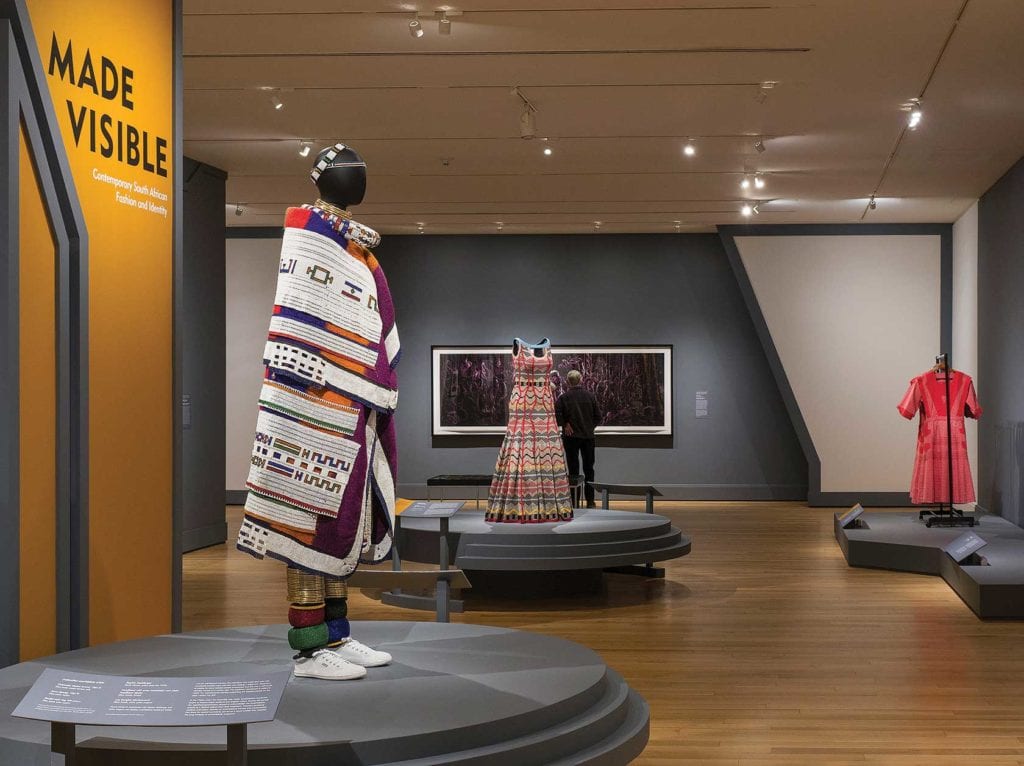
The first piece to confront viewers in the Museum of Fine Arts’ exhibition “Made Visible: Contemporary South African Fashion and Identity” is a blend of old and new. A mannequin wears white Keds along with a large beaded cape and intricately created leg bangles by Sophie Mahlangu. This amaNdebele beadwork operated as both a display of the artist’s skill and a visual protest against apartheid by reminding viewers of the long heritage of the amaNdebele kingdom. It’s this blend of tradition and modernity, protest and beauty that makes the exhibition a feast for the eyes and the mind.
Fashion, Concepts
Running through May 12, the show features South African fashion designers and an array of visual, performance and installation artists who utilize clothing or textiles in their statement-making works. The catalog also runs the cultural gamut, giving a platform to South Africans denied their own rights and heritage under apartheid, including the Xhosa, Ndebele and Zulu communities, women, members of the LGBTQ community and artists in rural areas. Some of the works were created during apartheid, such as the Mahlangu accessories, and some were created in the last decade, revealing the lingering stamp the conflict has left on cultural memory.
On the reverse of the Mahlangu installation is a ready-to-wear ensemble by Laduma Ngxokolo from his 2018 collection. To the unknowing viewer, it appears that the bright colors and mixing patterns are merely taking advantage of current trends, straight down to the Nike sneakers. But the patterns are actually inspired by historical beadwork like the pieces on the other side of the display. The geometric black-and-white graphics on the sleeve of the mannequin’s sweater are drawn from 19th-century amaXhosa women’s skirts. The seamless design elements are also meant to illustrate luxury and high-quality craftsmanship, in order to fight stereotypes abroad about black-owned businesses. Here, traditional patterns merge with contemporary style and quality. In addition, the important balance between men’s and women’s garments in the exhibition reminds viewers that textiles are not just women’s work.

Bhekezakhe, Parktown, 2016; Zanele Muholi (South African, born in 1972; Gelatin Silver Print; Courtesy of Shelly and Bruce Eckman; © Zanele Muholi. Courtesy of the artist, Yancey Richardson, New York, and Stevenson Cape Town /Johannesburg. PHOTO: COURTESY, MUSEUM OF FINE ARTS, BOSTON
The visual artwork is equally as striking. A 2013 photograph by Mary Sibande, “A Terrible Beauty is Born,” features a black woman wearing a rich purple gown at the center of the image. From the gown stem organic textile creatures that have created a wholly purple landscape around her. They grow out from a floral swirl of fabric at her middle, a reference to the ability of women to birth new life and new worlds. An apron is strewn gracefully around the figure, an allusion to the domestic work that many women were relegated to under the apartheid system. Here, she is shedding that last vestige of servitude. The color of the created world in the image refers to the anti-apartheid slogan, “The Purple Shall Govern.”
“Made Visible” presents a spectacular array of artwork, giving viewers a peek into the window of work made both under and after the apartheid regime. Clothing and textiles have remained an integral way for artists to comment on and protest conditions and to wear their cultural pride on their backs.







